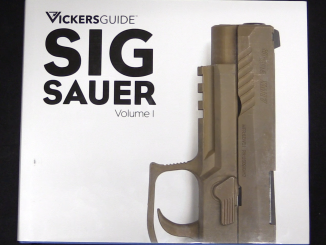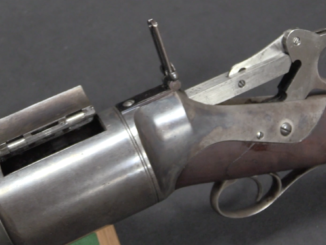We have another new unique item from the September 2013 Rock Island Premier auction today – a prototype pistol made by Savage in .38ACP caliber.
Related Articles

Book review
Book Review: Vickers Guide SIG SAUER, Volume 1
The most recent addition to the Vickers Guide series of books is SIG Sauer Volume 1. This is 460 pages covering SIG’s handguns and submachine guns from it’s very first contract (the Mannlicher 1894 blow-forward […]

Lever Action Rifles
Roper Repeating Rifle – An Early Type of Cartridge
While the design for the Roper rifle and shotgun originally came form Sylvester Roper, Christopher Spencer played a very significant role in its production. When sales of the Spencer lever action rifle dissolved at the […]

Needlefire
Q&A Video, November 2015
November 6, 2015
Ian McCollum
Needlefire, Paper cartridge, Percussion, Revolver, Semiauto pistol, Video
17
Thanks to the awesome people supporting Forgotten Weapons through Patreon for sending in more questions that I could get to for another month! This month the subjects include: Browning lock vs others in handguns Best […]

An interesting looking firearm. While I find the front end quite attractive, the grip looks too deep, and I’m not wild about a positioning of the mag release. Beyond the possibility of accidental manipulation, it seems like it would require a change in grip to depress intentionally.
Yes, I agree with the above with the addition that it is
a beautiful gun.
Looks like it was extremely well made and engineered.
I like the fact that it is cut from blocks of stainless steel.
If you can please let us know what the RIA sold it for.
Thank you Ian.
This pistol, looks to mutch like the Schouboe to be accidential. J T S Schouboe, got a US pattent in 1903 on his pistol
An interesting pistol with a very high level of craftsmanship, typical of much of Savage’s workmanship. I agree with Ian H and Pat Cassell about the placement of the magazine release. Also, the shape and configuration of the grip does not seem very ergonomic — but then again, it was a prototype, so proof of concept would have been a primary goal ( with refinements to follow later if successful ). I do like the massive gripping area on the rear of the slide, though.
Two random thoughts. First, suppose the Savage .45 had been adopted by the US military and had earned a reputation similar to the Colt 1911. Would we look back on John Brownings prototypes and say “What was he thinking with that unprotected magazine release, why it would pop the magazine every time you holstered the pistol.”? Second thought, I’ll bet somebody in the design team had experienced the classic semiauto accidental discharge wherein the shooter removes the magazine, forgets to operate the slide, and pulls the trigger to drop the hammer. The result of the above can run from mildly embarrassing to fatal. As for not selling today, I’m not so sure. Lots of institutions insist on a magazine safety and this set up would be even “safer”.
Today’s and yesterday’s measures are quite apart. One might ask:”…why did they need single action with iffy safety, if it can be done to perfection (and simpler)with double action?”
@P.Cassell
If the auction was September 2013 (as mentioned by Ian), and the Item # was 1773 (as written on the slip attached to trigger guard), then the price realized would be astonishing $18.400 – but that can’t be confirmed, as the past on-line catalogs seem to have vanished from the RIA site, which was a dastardly thing to do, denying a very useful searching tool.
Yes, that’s the lot number – thanks for checking it, Leszek. FYI, the catalogs are still online, but not searchable. Here’s the original listing:
http://www.rockislandauction.com/viewitem/aid/59/lid/1773
Shame it didn’t go into production, it looks better than the Colt .38 ACPs.
Me being a Browning fan, that is saying some thing.
The part of the slide that protrudes above the frame and the serrations on the top of the slide were to assist one in cocking it one-handed? When this gun was made the cavalry was still a big deal, and thereby the need to cock a pistol one-handed. I think that the need to support the horse soldier in the pre-WWI era had an impact on handgun design that is easily overlooked a hundred years later.
The magazine looks like a double stack. What was the magazine capacity?
AFAIK, Elbert Searle’s last name was pronounced as if it were spelled “surl”, as in “surly” minus the “y” at the end.
The Savage prototype bears a strong resemblance to the various pistols entered in the Soviet Army pistol trials of 1939. All but the Rakov (see below)had the same general outline as the Savage, with a slender revolver-like barrel to allow them to be fired through pistol ports in the turrets of the BT-5 and BT-7 “fast tanks”. The Rakov was built along the lines of the Tokarev TT-33.
Several of them had double-column magazines, as this one apparently does, with 18-shot capacity in 7.62 x 25mm Tokarev being the desired capacity. Locking systems varied; the Rakov had a turning lock apparently similar to the Austrian Steyr 9mm or the Mexican Obregon .45, the Korovin had a Browning-type swinging link, and the Tokarev apparently had a P-35 type cam lock. (No documentation on its exact mechanism has been found.)
The Voyevodin had a locking system similar to the Mauser “Broomhandle” or the Nambu, by all indications. (This design had only a nine-shot magazine.)Voyevodin also submitted a similarly-patterned pistol, with 18-shot magazine,with a retarded-blowback action using a spring-loaded retarding block. (Blish-type similar to the Thompson SMG, perhaps?)
All prototypes had external hammers and single-action lockwork. The Rakov’s apparently followed Browning practice; the others seem to have more closely resembled the lockwork of the Mauser “Broomhandle”.
All of the competitors except the Rakov and the second Voyevodin had the rear of the slide/bolt assembly “built-up” like the Savage prototype. This may have been a way of adding mass to the bolt unit to prevent the breech from opening too early; this would tend to indicate that the locking mechanisms were not delaying unlocking until pressure in the breech had fallen to a safe level.
The Japanese Hamada 8 x 21mm automatic of 1943, a Browning-type blowback, had similar problems, which were not helped by the milling-out of two large “crescents” on top of the slide at the rear, which actually decreased slide mass right where it needed extra mass the most.
The similarity of the majority of the Russian 1939 pistol prototypes to the 1903 Savage could just be a coincidence. But the resemblance is startling, to say the least.
Source; Ezell, Edward C. Handguns of the World; Military Revolvers and Self-Loaders from 1870 to 1945. Harrisburg, PA; Stackpole Books, 1981. ISBN 0-8117-0816-0. Chapter 12, “Soviet Handguns 1917 to 1940” (specifically pp.525-532), and Chapter 16, “Japanese Handguns 1870 to 1945” (pp.626-628).
cheers
eon
Note: the Voeyvodin pistol (Russian: Пистолет системы Воеводина) was produced in quantity: “no more than 1500” or “1000-1500” depending on source. One was used as a gift for Stalin – this example is now in the Military Historical Museum of Artillery, Engineers and Signal Corps in Sankt Petersburg.
Article in Russian wikipedia: http://ru.wikipedia.org/wiki/Пистолет_системы_Воеводина_(1939)
pics and info
http://translate.google.com/translate?hl=nl&sl=ru&tl=en&u=http%3A%2F%2Fwww.sb.by%2Fpost%2F154145%2F
Neat looking gun, somehow resembling Schwarzlose self-loader. Tokarev looks crude in comparison.
Really interesting gun. Patented Nov.,21 1905 with a SN 804984. Single action,
hammer firing seeming recoil operated but also seeming impossible to work in
this manner since using a stationary vertical lock piece working under the rearwardly
moving barrel extention. As can be seen in the Ian’s video, drawing back the breechbolt
does not move the barrel extention. Very strange design for a firearm genius like
Searle. Pistol looks internaly changed for the sake of looking as if it works. However,
pistol may work in mass locked form with purposedly enlarged breechbolt which did not
take place in the patent specification. The location of the Dismount Latch is also
very unpractical being ready nearly to break the trigger finger during recoil.
Protected by 38 claims in its patent but a dissappointed firearm.
Correction. Lock piece is not stationary but is a part of recoiling barrel extention
but it should work together with breechbbolt which seems not.
On patent drawings, the rocker arm actuation the vertical lock piece seems rather
weak in leverage which can be easily worn out with some usage. Possibly this might
be done in this prototype or it might be missed.
for a prototype the pistol looks very nice
A very pretty pistol indeed, particularly for 1905.